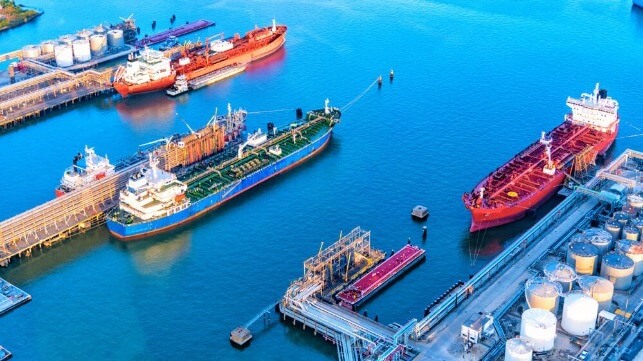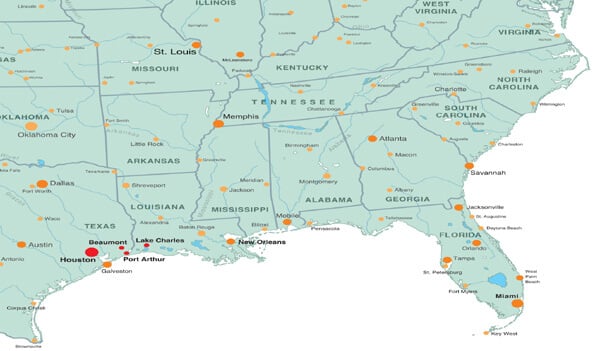Winds of Change for Energy Ports
Petrochemical ports see new opportunities in clean energy

(Article originally published in Mar/Apr 2024 edition.)
The global production of energy has taken a new twist: It has to be cleaner. Reducing carbon emissions and reaching “net zero” targets are terms becoming commonplace in the energy industry’s vocabulary.
Several U.S. ports that handle petroleum products or lease land to energy-producing companies are becoming more involved in the emissions reduction scenario, not only as depots for cleaner energy production but also as cleaner users. “Electric” seems to be the way to go – from drayage vehicles on docks moving containers to cranes and trucks and shore power for ships.
But not every port is following the conventional path in support of clean energy development.
Diverse Energy Needs
“As a bulk and breakbulk port, the Port of Beaumont is tied to energy in unexpected ways,” says Beaumont’s Port Director, Chris Fisher. “While aggregate, crude oil, wind turbine components and project cargo don’t seem related, they all support the diverse energy needs of the United States.”
Beaumont moves over one million tons of aggregate annually, most of which supports multi-billion-dollar refinery and petrochemical facility expansion efforts by laying the groundwork for upgrades. Aggregate also supports the maritime transportation network by supplying the base material needed to construct critical highway and road infrastructure that leads directly to ports and other industrial facilities.
As wind projects have been all the rage, Beaumont’s heavy-lift capabilities moved wind turbine components that supported 30 wind projects in the U.S. Fisher adds that with more than $85 billion in announced industrial projects along the Sabine-Neches Waterway, including Port Arthur LNG and Golden Pass LNG, Beaumont is a top choice for moving project cargo in support of exports and global energy needs. And as an energy exporter, Beaumont’s Jefferson Energy liquid bulk terminal, a net exporter of crude oil, gasoline and yellow wax, realized a 331 percent increase in volume over the last five years.
Port Tampa Bay, which handles 18 million tons of petroleum products per year or over 45 percent of Florida’s total, recently received an economic shot in the arm when Overseas Shipholding Group (OSG), a leading provider of energy transportation services, announced plans to study the development of a proposed Tampa Regional Intermodal Carbon Hub.
According to a release, the study is intended to evaluate the commercial feasibility of developing an intermediate storage hub at Port Tampa Bay for CO2 captured from industrial emitters across Florida. The hub would initially receive, store and process two million metric tons of CO2 per year, which would ultimately be transported by OSG vessels across the Gulf of Mexico for permanent underground storage.
It would be the first of its kind in the nation, and captured CO2 can actually be used in the production of synthetic fuels such as gasoline and diesel.

Petrochemical port operations in the Gulf of Mexico
Methanol and Wind
Port Lake Charles on the Gulf Coast of Louisiana has been chosen as the site of a planned major methanol plant to be built by Lake Charles Methanol II. The company plans to invest $3.24 billion to produce low-carbon intensity methanol and other chemicals.
“The proposed facility would reform natural gas and renewable gas feedstocks into hydrogen while capturing carbon dioxide, which would then be used to produce about 3.6 million tons per year of methanol,” it said in a statement.
Port Lake Charles’ Executive Director Richert Self adds, "This represents a significant capital investment for Southwest Louisiana. We’ll be involved in the export of three-to-four million tons of methanol per year. For the Port of Lake Charles, it’s yet another diversification of cargo. For years, we’ve handled petroleum coke and other fossil fuel-related energy cargoes, and methanol will complement that. It’s another area that displays that we’re truly an energy port.”
Port Lake Charles says another potential area of development may be offshore wind.
"Sites at the port’s industrial canal could become available to support the offshore wind industry as a marshaling and staging facility, an offshore wind component factory or both,” notes Director of Cargo & Trade Development Therrance Chretien.
The Port of Virginia, which is determined to become a net-zero operation by 2040, is transforming its Portsmouth Marine Terminal (PMT) into an offshore wind energy hub to support Dominion Energy’s Coastal Virginia Offshore Wind (CVOW) project and many other projects expected to be built along the U.S. East Coast.
Port spokesman Joe Harris says the improvements there, in support of Dominion’s project, are on-time and on-budget. Virginia wants to establish itself as a Mid-Atlantic logistics hub for the offshore wind energy industry: “We’re supporting this industry by providing a modern platform from which private industry (Dominion) can safely and efficiently operate.”
The first few loads of monopiles, which are base units that attach to the seafloor, have arrived and are on-site. The monopiles are over 250 feet in length and weigh nearly 1,500 tons on average.
Dominion has leased 72 acres of PMT, which is being used for the staging and pre-assembly of the CVOW components. Harris says the overall construction project will last 2.5 years and consist of 176 offshore wind turbines situated on a lease site 27 miles off the coast of Virginia Beach. Port investment in the project is $220 million.
L.A. and Long Beach
Upgrading facilities that currently handle petroleum products is under way at the Port of Los Angeles, says Michael Galvin, Director of Waterfront and Commercial Real Estate. The port has seven marine oil terminals that provide local fuel outlets with crude and products like diesel.
Galvin notes, “There’s a transition going on to renewable fuels,” with less carbon intense production. However, “Those fuels are being imported into our facilities now to meet specific energy producers’ needs in relation to regulations here in the State of California.”
While the port is focused on upgrading its present marine petroleum facilities, storing and supplying components for the various offshore wind projects developing along the California coast has been on its radar. “There have been discussions with various developers to utilize existing water space or land to do that,” Galvin says. But, he adds, the nearby Port of Long Beach “has a much larger proposal to develop” as a logistics base to supply wind energy components.
“On our side, we’ve looked at different developers to see what can be done on land or water but nothing is solid at this point,” Galvin says. The port would be happy to play a role in offshore wind where it can but “these companies need large pieces of land, like 100+ acres for long-term lease, and we just don’t have 100 acres to be used for that. So that’s an issue we have.”
The Port of Long Beach’s Pier Wind project is a proposed 400-acre terminal designed to facilitate the assembly of offshore wind turbines, which would be towed to wind farms in the ocean off central and northern California. If approved, it would be the largest facility of its kind in the nation and would help California meet its goals for sustainability and renewable energy sources.
Galvin concludes by saying, “The big goal here between the ports of L.A. and Long Beach is to get to zero emissions on our terminals by 2030 and off-terminal with our drayage truck fleet by 2035." – MarEx
The Maritime Executives' ports columnist Tom Peters writes from Halifax, Nova Scotia.
The opinions expressed herein are the author's and not necessarily those of The Maritime Executive.
